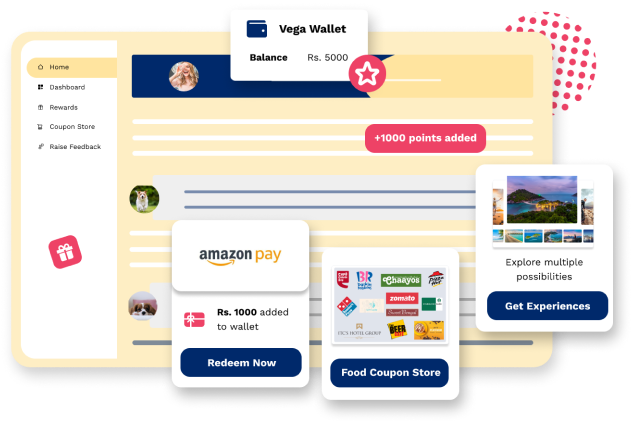Introduction
The word ‘recognition’ is synonymous with a positive work culture. According to a study by SHRM, over 91% of HR professionals believe that rewards and recognition make employees more likely to stay. Companies that foster healthy employee recognition do not promote it as an organizational aspect, but rather as a behavioral trait amongst employees.
Traditionally, any kind of formal recognition by the leadership group was considered the one medium of employees receiving appreciation. However, with the onset of peer–to–peer recognition, companies are able to explore more channels of employee appreciation which can be beneficial for the morale and productivity of the workforce.
But what exactly does this term mean? How exactly does it benefit a company? Read on to find out more!
What is Peer-to-Peer Recognition?
In a workplace that embraces peer-to-peer recognition, colleagues actively participate in recognizing the accomplishments and milestones of their peers. It essentially creates a new avenue for recognition where appreciation comes not only from the leadership but also from other colleagues.
According to TINYPulse, 41% of companies that use peer-to-peer recognition have seen a positive increase in customer satisfaction. Even a tiny word of appreciation, or an act of kindness, can go a long way in motivating your colleagues in the workplace. It stands out as a light of collaboration and recognition in the fabric of modern workplace practices.
There are many ways it can contribute to enhancing your workforce experience -
The Importance of Peer-to-Peer Recognition in the Workplace
Before understanding how peer-to-peer recognition as an aspect can contribute to the workplace, have you wondered why recognition is such a positive characteristic? Here’s what happens in our minds when we receive recognition -
- When someone receives appreciation, the neurons in their minds release a hormone called dopamine, also known as the happy hormone.
- These hormones later travel to the limbic system including the hippocampus, the brain's learning, and memory center, and the hypothalamus, stimulating them in the process.
- This induces positive emotions in the brain, like pride, satisfaction, motivation, and enjoyment, amongst others.
To Know More About The Psychology of Rewards
Ignite the cycle of Appreciation and Recognition. Experience the joy of rewards, the impact it creates, and the journey it starts.
Peer-to-peer recognition can be viewed from the objective of enhancing workplace positivity. Being recognized not only by leadership but also by our peers is a great motivating factor that can also induce the best in all of us. From an employee’s perspective, this is a really positive factor.
From a workplace perspective, however, there are many ways peer-to-peer recognition benefits can contribute to your work culture, like the aspects mentioned below -
- Eliminates Hierarchical and Departmental Barriers - Peer-to-peer recognition encourages cross-departmental collaboration and teamwork. It encourages employees to view themselves as part of a larger team working towards a common goal, rather than being confined to their individual departments. This collaborative mindset helps overcome departmental barriers and promotes a culture of cooperation and knowledge sharing.
- Enhances Company Culture – This type of recognition also helps in reinforcing the core values of the company. When employees recognize their colleagues for embodying these values, it sends a powerful message about what the organization stands for and what behaviours are encouraged and celebrated. This alignment between recognition and values helps shape the culture and creates a shared understanding of the desired norms and behaviors within the company. According to Mercer, 83% of HR leaders feel that engagement programs benefit organizational values and 85% feel that they benefit the company culture.
- Builds Confidence and Self-Esteem – Peer–to–peer recognition carries a unique weight and impact. Knowing that their peers value their contributions helps employees build confidence in their abilities and reinforces their sense of self-worth. It provides reassurance that their work is making a positive impact and adds to their overall confidence and self-esteem.

Creating a Positive Feedback Loop: How Peer-to-Peer Recognition Drives Motivation
A firm feedback structure is a hallmark of every successful organization. It highlights expectations and helps us understand where we stand in accordance with them. From a big-picture perspective, appreciation is also feedback. It is a positive acknowledgment of the work done and helps us understand our roles better. If positive and negative feedback is two sides of a coin, recognition, especially peer–to–peer recognition, has a major contribution towards the positive side.
The act of recognizing and appreciating each other's achievements creates a ripple effect within the workplace. The cycle of recognition and motivation continues as individuals are encouraged to surpass their previous achievements, leading to a continuous drive for improvement and growth.
It also taps into the fundamental human need for social connection and belonging. When employees receive recognition from their peers, it strengthens their sense of belonging within the team and organization. They feel valued and appreciated by their colleagues.
The power of recognition lies in its authenticity and relatability. Colleagues understand the challenges and achievements of their peers on a deeper level compared to managers or supervisors.
Implementing a Peer-to-Peer Recognition Program: Best Practices and Strategies
Implementing a peer-to-peer recognition program can significantly contribute to fostering a positive and supportive work culture. Here are some best practices and strategies to consider:
Clearly Define the Purpose and Objectives: Start by clearly defining the purpose and objectives. Determine what behaviors or achievements should be recognized and how they align with the organization's values and goals. Communicate these objectives to employees to ensure a shared understanding of the program's purpose.
Make it Easy and Accessible: Ensure that the peer-to-peer recognition program is user-friendly and easily accessible to all employees. Implement a platform or system that allows employees to submit and receive recognition effortlessly. Consider using digital tools, such as mobile apps or online platforms, to make the process seamless and convenient.
Encourage Frequent and Specific Recognition: Encourage employees to provide frequent and specific recognition to their peers. Encourage them to acknowledge not only major accomplishments but also smaller wins and efforts. Specific recognition that highlights the impact and significance of the employee's contributions is more meaningful and helps reinforce desired behaviors.
Lead by Example: Leadership involvement is crucial for the success of this program. Leaders should actively participate in the program by recognizing and appreciating employees' contributions. This sets the tone for the rest of the organization and encourages widespread adoption of the program.
Provide Training and Guidelines: Offer training or guidelines to employees on how to give effective and meaningful recognition. Educate them on the importance of specific and timely feedback. Provide examples of effective recognition messages to guide employees and help them understand the impact their words can have on their peers.
Celebrate and Share Success Stories: Share success stories of these initiatives by highlighting exceptional examples of recognition and the positive outcomes that resulted from it. This not only recognizes individuals for their contributions but also inspires others to participate in the program and contribute to a positive work culture.
Evaluate and Iterate: Continuously evaluate the effectiveness of your recognition programs. Solicit feedback from employees to identify areas for improvement and address any challenges or barriers that may arise. Adapt and iterate the program as needed to ensure its ongoing success and relevance.
Amazing Peer-to-Peer Recognition Ideas for your Workforce
Here are some per-to-peer recognition ideas that can help you start off -
Random Acts of Kindness: Encourage employees to perform random acts of kindness for their counterparts. Small gestures such as sending a meaningful note, bringing in their favorite food, or assisting with a task without being asked are examples of this. It fosters a loving and supportive work environment.
Team Celebrations: Organize regular team celebrations to acknowledge team accomplishments and milestones. This can include team lunches, outings, or virtual events where everyone can come together to celebrate their collective achievements.
Peer-to-Peer Awards: Create unique awards that employees can nominate their peers for based on specific traits, skills, or contributions, like ‘ The Ace Employee’, or ‘The MVP’. Recognize and present these awards during team meetings or special events.
Employee-led Initiatives: Empower employees to create and lead their own recognition initiatives. Encourage them to form recognition committees or task forces responsible for developing and implementing creative ways to appreciate their colleagues.
Gamification: Introduce a gamified system where employees can earn points or badges for recognizing their peers. These points can be redeemed for rewards or privileges, adding an element of friendly competition and engagement to the recognition process.

Overcoming Challenges in Establishing Peer-to-Peer Recognition Initiatives
Establishing initiatives that can positively impact the work culture, especially from a recognition perspective comes with its own set of challenges. So, it's important to be aware of potential challenges that may arise and strategize accordingly. Here are some common challenges and strategies to overcome them:
Lack of Awareness and Understanding: One of the main challenges is the lack of awareness of its benefits and understanding of the importance of such initiatives. To overcome this, educate employees about the value of recognizing their peers and how it contributes to a positive work culture. Communicate the purpose, objectives, and expected outcomes of the program to generate enthusiasm and buy-in.
Resistance to Change: Some employees may be accustomed to a traditional top-down recognition approach or may be skeptical about the effectiveness of sideways recognition such as this. Address this by involving employees in the process from the beginning, seeking their input, and addressing their concerns. Highlight the advantages, such as increased engagement, collaboration, and empowerment.
Lack of Visibility and Celebration: Peer-to-peer recognition initiatives may struggle to gain traction if achievements and recognition are not adequately highlighted. Create platforms or channels, such as internal newsletters, social media groups, or recognition walls, to showcase and celebrate employees' accomplishments. Regularly communicate the success stories of employees to the entire organization, reinforcing the importance of recognition and creating a culture of appreciation.
Limited Resources for Rewards and Incentives: The availability of resources for rewards and incentives can pose a challenge if not planned correctly. Explore creative and cost-effective alternatives for rewards, such as personalized thank-you notes, public recognition during team meetings, additional training opportunities, or flexible work arrangements. Emphasize the value of non-monetary recognition, focusing on the thoughtfulness and sincerity behind the acknowledgment.
Conclusion
The best thing about this kind of recognition mainly is that it can fit into any workplace culture, irrespective of the workforce size or line of work. With the right tools, it can very quickly become a very important asset for your organization. This is where Vega HR can help you. Our platform can help you enhance your work culture with different peer-to-peer recognition ideas!
With Vega HR, you can establish a recognition structure where an employee can appreciate their peers and their superiors. Thanks to on-spot recognition, employees can also instantaneously raise feedback for their peers and have the option of sharing it with the entire workforce with the help of our very own internal social network.
From a leadership perspective, it helps you keep tabs and constantly evaluate the impact of such positive initiatives with the help of our detailed reports and analytics. To know more about Vega HR can benefit your workforce, contact us now!
About Vega HR
Vega-HR is a powerful tool in the talent war, offering employee rewards, recognition, and pulse recognition. With an engaging platform, it fosters a world-class work culture, providing P2P recognition, social feedback, on-spot recognition, and monetizable incentive solutions with 3000+ coupons in various categories.
Create a Culture People Want to Stick to
- Send rewards
- Give shoutouts
- Build a community
- Gift experiences
Get a demo
 Written by Varshith Mittapalli 23 May 2023 | 4 min read
Written by Varshith Mittapalli 23 May 2023 | 4 min read






